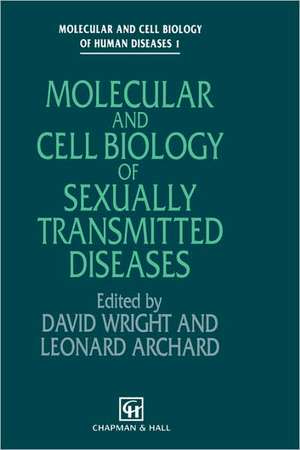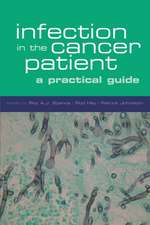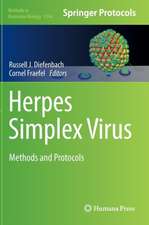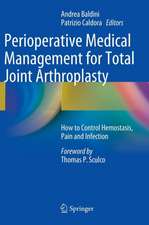Molecular and Cell Biology of Sexually Transmitted Diseases: Molecular and Cell Biology of Human Diseases Series
Editat de D.J. Wright, L. C. Archarden Limba Engleză Hardback – 30 sep 1992
| Toate formatele și edițiile | Preț | Express |
|---|---|---|
| Paperback (1) | 653.33 lei 6-8 săpt. | |
| SPRINGER NETHERLANDS – 5 noi 2012 | 653.33 lei 6-8 săpt. | |
| Hardback (1) | 649.06 lei 6-8 săpt. | |
| SPRINGER NETHERLANDS – 30 sep 1992 | 649.06 lei 6-8 săpt. |
Preț: 649.06 lei
Preț vechi: 763.60 lei
-15% Nou
Puncte Express: 974
Preț estimativ în valută:
124.20€ • 129.94$ • 103.17£
124.20€ • 129.94$ • 103.17£
Carte tipărită la comandă
Livrare economică 03-17 aprilie
Preluare comenzi: 021 569.72.76
Specificații
ISBN-13: 9780412365102
ISBN-10: 0412365103
Pagini: 318
Ilustrații: XXII, 318 p.
Dimensiuni: 155 x 235 x 21 mm
Greutate: 0.66 kg
Ediția:1992
Editura: SPRINGER NETHERLANDS
Colecția Springer
Seria Molecular and Cell Biology of Human Diseases Series
Locul publicării:Dordrecht, Netherlands
ISBN-10: 0412365103
Pagini: 318
Ilustrații: XXII, 318 p.
Dimensiuni: 155 x 235 x 21 mm
Greutate: 0.66 kg
Ediția:1992
Editura: SPRINGER NETHERLANDS
Colecția Springer
Seria Molecular and Cell Biology of Human Diseases Series
Locul publicării:Dordrecht, Netherlands
Public țintă
ResearchCuprins
1 Molecular mechanisms of antigenic variation in Neisseria gonotthoeae.- 1.1 Introduction.- 1.2 Gonococcal pathogenesis.- 1.3 Diagnosis and treatment of gonorrhoea.- 1.4 The surface of N. gonorrhoeae.- 1.5 Immune responses in gonorrhoea.- 1.6 Mechanisms of antigenic variation.- 1.7 Pili.- 1.8 Protein II.- 1.9 Conclusions.- References.- 2 Molecular biology of chlamydiae.- 2.1 Chlamydiae and human diseases.- 2.2 Chlamydial life cycle.- 2.3 Chlamydial chromosome.- 2.4 Chromosomal genes and products.- 2.5 Chlamydial antigens.- 2.6 Plasmid.- 2.7 DNA probes for the detection of chlamydiae.- 2.8 Chlamydial nucleic acids in tissue culture.- 2.9 Chlamydial nucleic acids in specimens.- 2.10 Amplified chlamydial nucleic acids.- 2.11 The story to date.- Acknowledgements.- References.- 3 Sexually transmitted mycoplasmas in humans.- 3.1 Classification.- 3.2 Sexually transmitted human species of mycoplasmas.- 3.3 Diseases associated with M. genitalium.- 3.4 Diseases associated with M. fermentans.- 3.5 Diseases associated with M. hominis.- 3.6 Diseases associated with U. urealyticum.- 3.7 Cell biology of mollicutes.- 3.8 Distinguishing properties of the genera and species.- 3.9 Molecular biology of mycoplasmas.- 3.10 Nucleic acid and immunological probes for detecting pathogenic mycoplasmas.- 3.11 Pathogenic, disease-related and immunogenic components of mycoplasmas.- 3.12 Pathogenic mechanisms of M. genitalium.- 3.13 Pathogenic mechanisms of M. fermentans.- 3.14 Pathogenic mechanisms of M. hominis.- 3.15 Pathogenic mechanisms of U. urealyticum.- References.- 4 Molecular biology of Treponema palIidum.- 4.1 Syphilis.- 4.2 The cell envelope of T. pallidum.- 4.3 The T. pallidum genome and molecular cloning of genes.- 4.4 Treponema pallidum lipoproteins.- 4.5 Glycosylation.- 4.6 The endoflagellum.- 4.7 The heat-modifiable oligomeric 4D antigen.- 4.8 Translational and transcriptional signals.- 4.9 Recombinant technology in the diagnosis of syphilis.- 4.10 Pathogenesis of T. pallidum.- 4.11 The surface of T. pallidum and immunity.- 4.12 The central paradox.- 4.13 Antigenic variation.- 4.14 Vaccines against syphilis.- Acknowledgements.- References.- 5 Molecular biology of Candida pathogenesis.- 5.1 Introduction.- 5.2 Growth of Candida as it relates to pathogenesis.- 5.3 The biology of dimorphism as it relates to pathogenesis.- 5.4 High frequency switching as it relates to pathogenesis.- 5.5 Genotypic variability as it might relate to pathogenesis.- 5.6 Other phenotypic traits as they relate to pathogenesis.- 5.7 The application of molecular genetic tools to questions of Candida etiology and epidemiology.- 5.8 The basic questions which remain unanswered and why.- 5.9 The range of methods used to assess genetic relatedness between Candida strains.- 5.10 Preliminary answers to epidemiological and etiological questions using DNA fingerprinting.- 5.11 Discussion.- Acknowledgement.- References.- 6 Molecular analysis of Trichomonas vaginalis surface protein repertoires.- 6.1 Introduction.- 6.2 Antigenic diversity and the immunogen repertoires.- 6.3 The double-stranded RNA virus of T. vaginalis.- 6.4 Batch versus chemostat grown trichomonads and antigenic diversity.- 6.5 Cytoadherence and the trichomonad adhesin repertoire.- 6.6 The nutrient acquisition protein repertoires.- 6.7 Conclusions.- References.- 7 Hepatitis B virus and hepatitis delta virus.- 7.1 Introduction.- 7.2 Biology of hepatitis B virus.- 7.3 Epidemiology and transmission of hepatitis B.- 7.4 Acute hepatitis B.- 7.5 Chronic hepatitis B.- 7.6 Treatment.- 7.7 Prevention.- 7.8 New hepatitis B vaccines.- 7.9 Hepatitis delta virus (HDV).- References.- 8 Molluscum contagiosum virus.- 8.1 Introduction.- 8.2 Clinical features.- 8.3 Pathology.- 8.4 Immunology.- 8.5 Transmission and epidemiology.- 8.6 Virion structure and life cycle.- 8.7 Attempts at virus propagation.- 8.8 Genome structure and organization.- 8.9 Molluscum contagiosum virus subtype nomenclature.- 8.10 Molecular epidemiology.- 8.11 Possible mechanisms of MCV-induced tumourigenesis.- 8.12 The Molluscum contagiosum virus homologue of the vaccinia virus major envelope protein: control of MCV gene expression.- References.- 9 Molecular biology of herpes simplex virus.- 9.1 Introduction.- 9.2 Taxonomy.- 9.3 The herpes virus virion.- 9.4 The viral genome.- 9.5 Productive infection.- 9.6 Latency.- 9.7 Virulence.- 9.8 Antiviral agents.- 9.9 Immunization against infection.- 9.10 Detection of HSV.- References.- 10 Anti-idiotypic therapeutic strategies in HIV infection.- 10.1 Introduction — the CD4/gp120 interaction.- 10.2 The CD4 molecule — structure and function.- 10.3 gp120 — structure and function.- 10.4 Homology of gp120 with members of the immunoglobulin supergene family (IgSF).- 10.5 Immunosuppressive effects of gp120 in vitro.- 10.6 The anti-idiotype strategy.- 10.7 Epitope mapping of CD4.- 10.8 Conclusions.- References.
Recenzii
`... a collection of excellent reviews... a valuable source of information to potential research workers as well as a useful reference for those currently involved in research into sexually transmitted diseases.'
Journal of Medical Microbiology
Journal of Medical Microbiology














